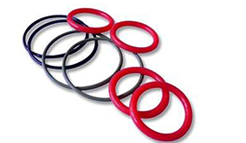 Lubrication of O-rings is essential for the proper function and full-service life of the seal, but also to ensure the machine, motor, engine, or device in which it is placed does not malfunction from a blown seal. A grease or oil application at assembly helps to protect the O-ring from damage during use. An additional benefit is the protection a lubricant provides for the part, from general water resistance and minimization of frictional forces to preventing atmospheric degradation by elements such as ozone. Lubricated O-rings reduce asperities of metal edges that may leak vacuum applications and seal pneumatic applications requiring dynamic service.
Lubrication of O-rings is essential for the proper function and full-service life of the seal, but also to ensure the machine, motor, engine, or device in which it is placed does not malfunction from a blown seal. A grease or oil application at assembly helps to protect the O-ring from damage during use. An additional benefit is the protection a lubricant provides for the part, from general water resistance and minimization of frictional forces to preventing atmospheric degradation by elements such as ozone. Lubricated O-rings reduce asperities of metal edges that may leak vacuum applications and seal pneumatic applications requiring dynamic service.
Knowing how to lubricate an O-ring, which lubricant is best, and when to apply it will provide stability, maintain consistency, and optimize the service life of your O-ring. Let’s take a closer look:
How to Lubricate O-Rings
Providing a thin, uniform coating of lubricant on the surface of O-rings before installation increases the part’s functionality, eases installation, and extends its service life. The application of a thin film of lubricant covering the O-ring will fill in any gaps or spaces where the O-ring joins the mated part or parts. Properly applied, lubrication prevents drying out, reduces tension between surfaces, and fits the part more snugly into place.
Though there are several methods of applying lubricant to an O-ring, the three more common ways are:
- Apply the lubricant directly to the O-ring using a brush or your fingers; spread or brush evenly.
- Dip the O-ring into a container of lubricant.
- Dispense the lubricant directly into the O-ring packaging and spread evenly within.
Which Lubricants Are Best for the Application?
Numerous types of lubricants can be used to install O-rings. Among the more common choices are petroleum distillates, solvents, soap and water, polymers, and ester-based grease products. Unfortunately, many of these traditional choices also have caused health and safety concerns combined with damage to the rubber O-ring.
Petroleum-based products can cause elastomeric rubber to swell or dry out. Solvents are not ideal lubricants and contain high Volatile Organic Compounds (VOCs) that may be flammable or pose very real health risks. Soap and water solutions are safer solutions than solvents and petroleum-based lubricants but are nominal, inconsistent, and reactivated in damp environments after assembly.
As most O-rings and seals are made of synthetic elastomeric polymers, i.e., “rubber” material such as nitrile, EPDM, and Neoprene, they are the best lubricants for them derived from synthetic compounds. At the top of the list are silicone-based and ester-based lubricants. In comparison to other types of lubricants, synthetic-based lubricants perform better over a wide range of conditions. They offer an excellent reduction in friction, are waterproof, and have low volatility, high-temperature stability, and low-temperature fluidity. Where ester-based lubricants are biodegradable, both are safe, and neither pose health risks or contamination by contact when you use your hands or fingers for application. These lubricants can be used on natural rubber products as well.
When to Apply or Reapply Lubricants to O-Rings
The first step to ensure a long life for an O-ring application is at the time of installation. Look to any manual or set of directions, and it is highly recommended to lubricate most seals before installing or changing them properly. Proper lubricants help protect O-rings from damage due to abrasion, pinching, or cutting, all of which could lead to premature product failure. The issues that arise with poor or underperforming O-rings—tearing, overstretching, and improper seating—usually occur during installation. Lubricating the part will help prevent these problems. Applying a thin, uniform film of lubricant will help seat the O-ring correctly and fit tightly.
Take the time to wipe clean and reapply a fresh coat of lubrication on O-ring parts during routine maintenance or when making repairs of mechanical equipment, devices, engines, machinery, and so forth that house O-rings.
O-rings are in many ways an indispensable component found in countless applications. They play an essential role in the manufacture and operation of vehicles, machinery, appliances, plumbing, pumps, motors, medical devices, and much more. For O-rings to function correctly, care must be given during installation. Surfaces should be wiped clean and free of foreign material or substances and then lubricated to increase functionality, extend the service life, and provide extra protection for the part or component. In short, knowing how to lubricate an O-ring, when to apply it, and selecting the best lubricant for the application will ensure a long service life for the part.


